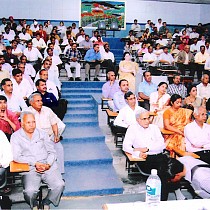DIFFERENTIAL RESPONSE OF BRASSICA SPECIES TO THE MUSTARD APHID (LIPAPHIS ERYSIMI KALTENBACH) IN EASTERN RAJASTHAN
 Directorate of Rapeseed–Mustard Research, Sewar, Bharatpur – 321 303, Rajasthan (India)
* Post harvest Technology Scheme, CTAE, MPUAT, Udaipur –313 001 (Rajasthan)
** Agricultural Research Station, MPUAT, Ummedganj, Kota – 324 001 (Rajasthan)
Y. P. SINGH, K. C. SHARMA* AND H. P. MEGHWAL **
The study on avoidable yield losses in rapeseed–mustard due to mustard aphid (Lipaphis erysimi Kaltenbach) was conducted at National Research Centre on Rapeseed–Mustard, Sewar, Bharatpur, consecutively for ten years from 1996– 97 to 2005–06 during Rabi season under field conditions. The yield losses varied on the infestation intensity of mustard aphid and Brassica species. In all the years of experiments, significant higher yields were obtained from protected plots as compared to unprotected plots except during 1998–99 due to negligible infestation of mustard aphid. Over the years, the maximum yield loss of 92.09 per cent was recorded in gobhi sarson (Brassica napus var. HYOLA–401) during 2000–01 followed by Indian mustard (Brassica juncea var. PCR–7) 90.97 per cent during 1997–98 and brown sarson (Brassica campestris var. BSH–1) 90.11 per cent during 1996–97. The minimum yield loss of 5.39 per cent was recorded in taramira (Eruca sativa var. T–27) in 2001–02 followed by 5.83 per cent in karan rai (Brassica carinata var. BCNRC–1) in 1999–00 and 9.25 per cent in Indian mustard (B. juncea var. Varuna) in 2005–06. The mean avoidable yield loss in 10 years of the study, the highest 37.90 per cent was recorded in brown sarson and the lowest 5.61 per cent in taramira. The reduction in oil content was found 0.66 to 8.19 per cent in Indian mustard, 0.22 to 6.81 per cent in brown sarson, 0.08 to 3.01 per cent in yellow sarson, 0.33 to 4.77 per cent in gobhi sarson, 0.02 to 2.67 per cent in karan rai and 0.03 to 2.84 per cent in taramira. The mean oil loss in 10 years was found 1.98 per cent in Indian mustard, 3.12 per cent in brown sarson, 1.83 per cent in yellow sarson, 2.53 per cent in gobhi sarson, 0.96 per cent in karan rai and 0.71 per cent in taramira. The most important factor determining the extent of losses was the coincidence of peak flowering of cultivars with the peak aphid population. The studies revealed that the yield losses were greatly influenced in the different seasons and different Brassica species.


